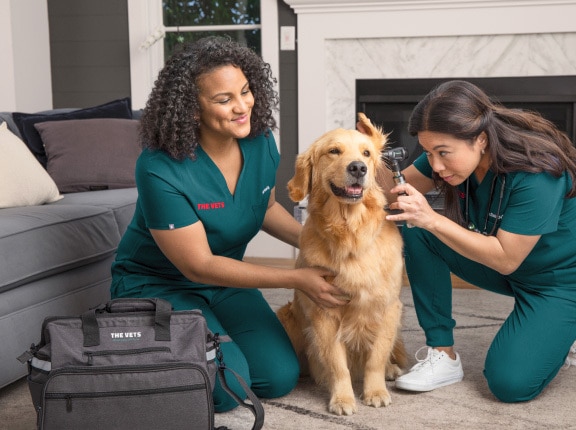Why Pet Rehab Is Crucial: the Advantages of Vet Providers for Your Animal's Recuperation
Pet rehab is an essential part of recuperation for pet dogs dealing with injuries or specials needs. Veterinary services give essential assistance through tailored rehabilitation plans that address specific needs. These strategies frequently consist of pain administration, physical treatment, and dietary guidance. Recognizing the numerous aspects of pet rehab can brighten its relevance in improving recovery outcomes. What details advantages do these solutions use, and how can they change a family pet's healing trip?
Understanding Pet Recovery
Animal rehab encompasses a series of therapeutic techniques focused on bring back the health and performance of hurt or disabled animals. This area incorporates numerous strategies, consisting of physical treatment, hydrotherapy, and work treatment, customized to satisfy the details needs of each animal. Rehabilitation professionals examine an animal's problem, creating individualized treatment plans that might entail exercises to reinforce muscles, enhance mobility, and boost overall health. The process not only concentrates on physical recovery yet also addresses emotional and behavior facets. Animals often experience stress and anxiety and anxiety following an injury, making psychological health considerations vital in rehab. By creating a supportive setting, therapists can help animals reclaim their self-confidence and adapt to their new scenarios. With regular sessions, pets can experience substantial renovations, inevitably leading to a much better lifestyle. On the whole, understanding pet rehabilitation highlights its significance in advertising recovery and improving the bond between pets and their proprietors.
The Function of Discomfort Administration in Healing
How crucial is effective pain administration in the healing of hurt animals? It plays a crucial role in facilitating recovery and enhancing the overall health of animals. Correct pain management not only eases pain but likewise promotes mobility, making it possible for pets to take part in rehabilitation activities needed for recovery. When discomfort is effectively taken care of, animals have a tendency to respond favorably to treatment, resulting in quicker rehab outcomes.Veterinarians utilize different techniques to assess and resolve pain, including medicines, acupuncture, and alternate treatments. By tailoring discomfort management techniques to the individual demands of each animal, vets can assure that pets stay tranquil and cooperative throughout their recuperation trip. Lessening pain assists reduce stress and anxiety, which can prevent healing and lengthen recovery times. To sum up, reliable discomfort management is important for boosting the recovery process and improving the top quality of life for damaged animals.
Physical Therapy Strategies for Animals
Countless physical therapy methods are offered to help in the rehabilitation of animals recuperating from injuries or surgical procedures (emergency vet). These methods can improve wheelchair, soothe discomfort, and advertise recovery. Therapeutic exercises, as an example, help strengthen muscles and improve joint function, permitting animals to regain their physical capacities gradually. Hands-on therapy, that includes massage therapy and mobilization, can reduce tension and enhance circulation, contributing to a faster recovery.Other strategies such as easy variety of movement workouts encourage joint adaptability and reduce stiffness. Additionally, electrical excitement treatment might be used to stimulate nerves and muscles, promoting healing and pain relief.Veterinary specialists often tailor these techniques to each pet dog's specific needs, making sure a detailed recovery strategy. By executing these physical therapy approaches, family pets can experience improved high quality of life and a much more effective healing from their disorders. The combination of these techniques into rehabilitation programs is essential for excellent recovery end results
Benefits of Hydrotherapy for Rehabilitation
Hydrotherapy uses considerable advantages in animal recovery, specifically in improving flexibility. This water-based therapy advertises discomfort relief while giving comfort to harmed or recouping animals. In addition, it facilitates strength-building workouts that add to overall physical recuperation.
Boosted Flexibility Renovation
As animals recuperate from injuries or surgeries, boosted wheelchair commonly ends up being a primary objective of their rehab. Hydrotherapy serves as a useful tool in attaining this objective. Via water-based exercises, animals can participate in low-impact motions that help with joint movement and enhance muscles without the tension of weight-bearing activities. The buoyancy of water supports their bodies, permitting boosted array of motion and movement enhancement. In addition, hydrotherapy encourages much better balance and coordination, which are vital for bring back regular movement patterns. Routine sessions can lead to considerable progression in an animal's physical abilities, inevitably boosting their lifestyle. This approach not just help in recuperation but also promotes an extra energetic and satisfying way of life post-rehabilitation.
Discomfort Relief and Convenience

Remedy for pain is an essential element of animal recovery, and hydrotherapy considerably contributes to this procedure. By utilizing water's buoyancy, hydrotherapy minimizes joint anxiety and minimizes discomfort during motion. This restorative technique provides a soothing setting where pet dogs can participate in gentle workouts without the complete weight of their bodies affecting their recuperation. The warm water boosts blood flow, advertising recovery while also motivating relaxation. Additionally, hydrotherapy sessions can be customized to satisfy the particular demands of the pet, making sure suitable comfort. As animals experience lowered pain and increased convenience degrees, their overall determination to take part in rehab tasks frequently enhances, bring about a more efficient recuperation journey. Consequently, hydrotherapy acts as an essential tool in improving discomfort alleviation and comfort throughout rehab.
Toughness Building Workouts
Strength-building exercises play a crucial function in the rehabilitation procedure, with hydrotherapy offering distinct benefits. This form of treatment utilizes water resistance to boost muscular tissue strength without placing too much pressure on the joints. The buoyancy of water supports the family pet's weight, allowing for more secure movement and boosted range of activity. In addition, hydrotherapy can boost cardiovascular health and promote total health and fitness, assisting in quicker recuperation from injuries or surgeries. The controlled atmosphere additionally minimizes the danger of reinjury, making it an ideal choice for pet dogs requiring rehab. Normal hydrotherapy sessions can lead to obvious improvements in mobility, toughness, and endurance, inevitably improving the family pet's top quality of life and capacity to return to regular tasks.
Importance of Personalized Rehabilitation Strategies
Customized rehabilitation plans are necessary for attending to the special requirements of each animal, making sure individualized treatment strategies. These strategies enable efficient development monitoring and needed adjustments, promoting ideal healing results. Furthermore, an alternative method can improve the overall well-being of the animal, promoting a more thorough rehabilitation experience.
Individualized Therapy Approaches
While numerous recovery programs adopt a canine vet one-size-fits-all technique, the unique requirements of each pet require customized therapy strategies for optimal recuperation. Customized rehabilitation plans consider various factors, consisting of the pet's types, age, case history, and particular injuries or conditions. By customizing treatments, vets can deal with each animal's one-of-a-kind obstacles, taking full advantage of the effectiveness of the rehabilitation process. Individualized plans might incorporate different modalities such as physical therapy, hydrotherapy, and restorative workouts, making certain that the therapy aligns with the pet's capabilities and progression. Furthermore, personalized strategies promote a more powerful bond between the pet and the caregiver, advertising an extra interesting and encouraging recovery setting. Ultimately, personalized treatment is crucial for achieving best possible results in pet rehabilitation.
Progression Tracking and Adjustments

Holistic Recovery Techniques
Alternative healing methods are crucial for efficient pet rehabilitation, as they stress the significance see this website of individualized therapy strategies customized per animal's particular demands. This technique thinks about the physical, emotional, and environmental aspects impacting healing. Personalized rehabilitation strategies may include a mix of physical treatment, nutritional therapy, and behavioral modifications. By attending to these diverse elements, veterinarians can improve the general health of the pet and promote a faster recovery. Such customized techniques help with a deeper understanding of the family pet's one-of-a-kind challenges, leading to a lot more efficient interventions. Ultimately, all natural healing approaches not only boost physical wellness yet also contribute to the animal's psychological and emotional stability, making certain a detailed rehab experience.
The Effect of Nourishment on Recuperation
Nourishment plays an essential duty in the recovery procedure for fixing up pets, commonly figuring out the speed and efficiency of healing. A well-balanced diet plan supplies the needed nutrients that support tissue repair service, improve the immune system, and improve total vitality. Protein is especially important, as it helps in muscular tissue rebuilding and healing from injuries. Crucial fatty acids, vitamins, and minerals additionally add to minimizing swelling and advertising optimal cellular function.Veterinarians regularly emphasize the relevance of tailored nourishment strategies, considering each animal's specific needs, age, and health and wellness condition. Correct hydration is just as important, as liquids help with nutrition absorption and help in cleansing. By guaranteeing that pet dogs get suitable nutrition, caregivers can significantly boost their possibilities of an effective recuperation, leading to far better long-term wellness outcomes. Inevitably, nutrition acts as a foundational element in the rehabilitation trip, sustaining pets in reclaiming stamina and strength post-injury or disease.
Success Stories: Pet Dogs Who Flourished After Recovery
Effective rehabilitation stories are plentiful, showcasing the strength of pet dogs who have actually conquered substantial obstacles. Take, for example, Bella, a gold retriever who experienced extreme injuries from an auto crash. With committed veterinary treatment and a complete rehab program, she regained her flexibility and returned to her lively self, much to her owner's delight. Max, a senior cat identified with arthritis, experienced amazing renovation via a mix of physical treatment and discomfort administration. His newfound dexterity permitted him to appreciate his favorite sunbathing places again. An additional inspiring situation is that of Coco, a saved greyhound who conquered anxiety with therapy and socialization methods, enabling her to flourish in her brand-new home. These success stories exemplify the transformative power of animal rehabilitation, stressing that with the ideal support, pet dogs can not just recuperate but lead meeting lives, enhancing the bonds they show their families.
Regularly Asked Concerns
The length of time Does the Rehabilitation Process Generally Take for Pet Dogs?
The rehabilitation procedure for animals normally differs based upon the injury or condition, ranging from a few weeks to a number of months. Individual progression, therapy kind, and dedication to exercises significantly affect the overall duration of recuperation.
Exist Any Type Of Threats Connected With Animal Rehab?
Pet rehab may lug dangers such as worsening of injuries, improper strategies resulting in discomfort, or insufficient monitoring during recovery. These aspects can impede development and influence the total efficiency of the rehabilitation procedure.

Can All Pets Gain From Rehabilitation Providers?
Not all animals might require recovery, but several can benefit greatly. Rehab solutions can improve wheelchair, ease pain, and improve total well-being, specifically for those recouping from injuries, surgeries, or chronic conditions.
Exactly How Can I Prepare My Animal for Rehab Sessions?

What Indicators Indicate My Pet Needs Rehabilitation?
Signs indicating a pet might require rehab consist of blog here problem walking, limping, decreased task degrees, hesitation to leap, or indicators of discomfort. Observing these habits can trigger owners to look for specialist analysis and therapy for their pet dogs.
Comments on “Post-Op Recovery Guide After Your Dog’s tplo surgery”